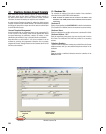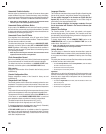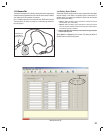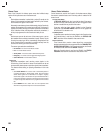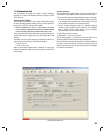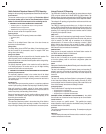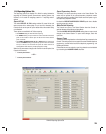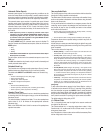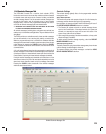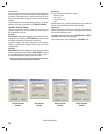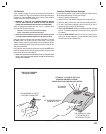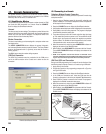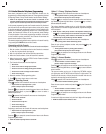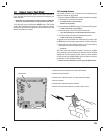22
Automatic Status Reports
Automatic status reports of all pending supervisory conditions can be
sent to the Central Station at a daily, weekly or monthly schedule until the
supervisory condition is cleared or corrected. If split reporting is enabled,
the automatic status report will be sent to the supervisory number only.
The automatic status report consists of a periodic test report, followed
operating mode report (Home Mode and Away Mode only) and any
supervisory conditions. Supervisory conditions that are covered by the
automatic status report include AC fail, Console low battery, missed
sensor supervision, and sensor low battery for all sensors learned in to
the Console.
✓ NOTE: Supervisory events are reported by automatic status report
regardless of the global REPORT SUPERVISORY EVENTS setting on
the Reporting Options tab. Also, AC power loss events are reported
by automatic status report regardless of the global REPORT AC FAIL
setting on the Reporting Options tab.
The default MODE setting for automatic status reports is disabled. To
have the Console send automatic status reports, select one of the three
MODE options:
• Daily
• Weekly
• Monthly
✓ NOTE FOR UL APPLICATIONS: UL requires the Automatic Status Report
Mode option be set to DAILY.
For each option, set the time for the automatic test report to occur in the
TIME area.
The DAY area selects the day of week or day of month for the weekly and
monthly automatic status reports.
Extended Event Log
The Console’s event log always records system alarm (Group 1) events.
Additional events are categorized as Group 2 and Group 3 events.
The default adds GROUP 2 and GROUP 3 events to the Console’s log:
Group 2
• Console mode changes (off, home, away, night)
• Activity sensor activations
• Inactivity alarm window expiration
• Reminder message timeout expiration
Group 3
• Remote access (RA4200) sessions
• Console supervisory events (AC power, low battery, phone trouble)
• Sensor supervisory events (supervision, low battery)
Speaker Phone Timer
The Console can be programmed to act as a hands-free speakerphone
for incoming calls. If the user forgets to hang up, a timer will automatically
disconnect the call.
The default disables Speakerphone Mode. To use the speakerphone
option, select 15, 30, or 60 minutes for the speakerphone automatic
disconnect timer.
Refer to the PERS-4200 User’s Guide for remote call-in speakerphone
operation instructions.
Two-way Audio Mode
The Console supports 2-way audio communications with the subscriber
through the Console’s speaker and microphone.
The default sets all Console sensors to have 2-way audio enabled. 2-way
audio can be enabled or disabled for individual sensors using the check
boxes on the Sensors tab.
If 2-way audio activation is selected for an emergency sensor, after the
monitoring service operator acknowledges the communicators report,
the Console will stop its siren (if enabled) and switch to the selected
audio mode for 90 seconds if:
• Two-way audio mode is selected (listen-only, two-way manual, or two-way
auto) in the RA4200 Reporting Options menu
— AND —
• The zone where an alarm is being reported is enabled for two-way audio.
Temperature Alarms have a separate setting to enable 2-way audio for
those types of alarms.
All other alarms or events are controlled solely by the global 2-way audio
setting in the Reporting Options menu and will go into 2-way audio if that
option is enabled.
There are four choices for 2-way audio:
• Disable (Globally) — Console will not report as an audio account to the
Central Station. No audio monitoring will occur.
• Two-Way Auto (default setting for PSTN reporting) — The Console
automatically switches between listen and talk depending on which party is
talking. The operator can still switch from listen to talk manually by pressing
“1”, or switch from talk to listen by pressing “3” on a telephone connected
to the line (with increased volume). Pressing “8” returns to two-way auto.
Pressing “9” disconnects the call. Press any key but “9” to extend the time
90 seconds.
• Two-Way Manual (default setting for IP reporting) — The operator will be
able to hear sound from the Console and will be able to talk through the
Console’s speaker. The operator can switch from listen to talk by pressing
“1”, or switch from talk to listen by pressing “3” on a telephone connected to
the line. Pressing “9” disconnects the call (press any key but “9” to extend
the time 90 seconds).
• Listen Only — The operator will be able to hear sound from the Console’s
microphone, but will not be able to talk through the Console’s speaker.
Pressing “9” on a telephone connected to the line disconnects the call
(press any key but “9” to extend the time 90 seconds).
Dialing Delay
To help reduce false alarms reported to the Central Station, a delay of
15 seconds can be entered for PSTN or IP reporting. During this delay
time, the subscriber can press the CANCEL button to cancel the alarm
reporting to the Central Station. After the delay, once the call is initiated
and the receiver handshake tone is detected (with PSTN reporting), or
the IP packet is sent (with IP reporting), the report cannot be cancelled.
The default setting for dialing delay is OFF.
4 x 2 Alarm Codes
The 4 x 2 reporting format uses four digits for the account number and
two digits for the alarm code.
The Console defaults for 4 x 2 reporting assigns alarm codes 11-26 to
Console zones 1-16, trouble codes 41-56 to Console zones 1-16, and 16
other general alarm codes.
Any of the default 4 x 2 alarm codes can be modifi ed as necessary. Enter
the new 2-digit code in the 4 x 2 area.



